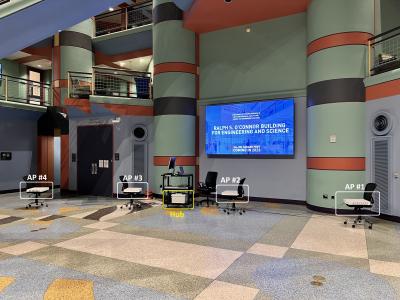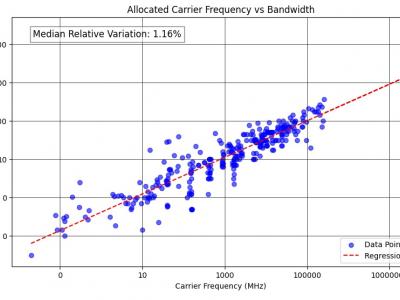Wireless Networking
We conducted a massive MIMO channel measurement and uplink multi-user data transmission experiment in an indoor setting on the Rice University campus. The original purpose of this dataset was to study the effect of placement of massive MIMO BS arrays on performance in two scenarios of co-located and separated (distributed) as well as the effect of phase coherence among the arrays during channel measurement and data transmission. Use the link to access the datasets.
- Categories:
 348 Views
348 Views
This dataset has been measured from the User Equipment (UE) using an Automated Guided Vehicle (AGV). The collected metrics include the radio information measured by the modem, and the localization information obtained from the AGV's navigation system based on LiDAR technology.
The AGV is configured to follow a loop movement from the south to the north of the laboratory at 1 m/s speed. The BTS is a commercial cell publicly available on mmWave, but no external users were connected to mmWave during the experiments.
- Categories:
 218 Views
218 Views
This dataset presents real-world VPN encrypted traffic flows captured from five applications that belong to four service categories, which reflect typical usage patterns encountered by everyday users.
Our methodology utilized a set of automatic scripts to simulate real-world user interactions for these applications, to achieve a low level of noise and irrelevant network traffic.
The dataset consists of flow data collected from four service categories:
- Categories:
 465 Views
465 Views
DALHOUSIE NIMS LAB BENIGN DATASET 2024-2 dataset comprises data captured from Consumer IoT devices, depicting three primary real-life states (Power-up, Idle, and Active) experienced by everyday users. Our setup focuses on capturing realistic data through these states, providing a comprehensive understanding of Consumer IoT devices.
The dataset comprises of nine popular IoT devices namely
Amcrest Camera
Smarter Coffeemaker
Ring Doorbell
Amazon Echodot
Google Nestcam
Google Nestmini
Kasa Powerstrip
- Categories:
 200 Views
200 ViewsThe dataset derived from the European Table of Frequency Allocations (ECA Table) represents a comprehensive compilation of frequency ranges and their associated bandwidths allocated for various applications across the electromagnetic spectrum, spanning from 8.3 kHz to 3000 GHz. This dataset is of interest to gain an understanding the distribution of frequency allocations and bandwidth usage in a regulatory framework, aiding in spectrum management and planning.
- Categories:
 268 Views
268 Views
In the conducted experiments using the ns-3 simulator, the performance of the Collision-Aware-Intel (CA-Intel) algorithm was evaluated under varying conditions to simulate different causes of frame errors. Key data points include:
1. Number of Clients (Transmitters): The number of clients varied between 1 and 6 to create different levels of network congestion and induce collisions. For a single client, errors were primarily attributed to poor SNR. As the number of clients increased, collision-induced errors became more prevalent.
- Categories:
 40 Views
40 Views
Common Randomness (CR) can be considered as a resource in our future communication systems that will assist in various operations, such as cryptographic encryption in wireless communication, improving identification capacity for identification codes. In wireless communication, CR can be conveniently generated by reading the reciprocal channel properties between two wireless terminals, and by sending pilot signals to each other using the time division duplexing (TDD)-based half-duplexing method. In the channel probing stage, reciprocal channel characteristics are measured.
- Categories:
 218 Views
218 Views
translator
- Categories:
 80 Views
80 Views
Integrated Access and Backhaul (IAB) networks
offer a versatile and scalable solution for expanding broadband
coverage in urban environments. However, optimizing the deploy-
ment of IAB nodes to ensure reliable coverage while minimizing
costs poses significant challenges, particularly given the location
constraints and the highly dynamic nature of urban settings. This
work introduces a novel Deep Reinforcement Learning (DRL)
approach for IAB network planning, considering urban con-
- Categories:
 135 Views
135 Views
Dataset containing real word data related to the informations receive on a downlink and an uplink channels. The information related to the data flowing on the channel are expressed by means of complex numbers. Some processing can be performed to convert the complex number into integer numbers in order to represent the channel as preferred. This dataset can be used to develop new compression and channel estimation algorithms.
- Categories:
 416 Views
416 Views
